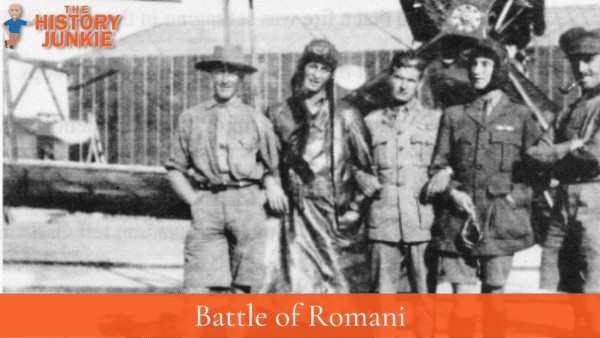The Battle of Romani in August 1916 was the second major attempt by Turkish forces to seize control of the Suez Canal, which was then under British control in World War 1.

Overview
British forces repulsed an earlier Ottoman attack on the Suez Canal in early February 1915. Both sides committed to the Gallipoli Campaign for the remainder of 1915, but the British maintained a strong presence at the canal to defend it from further attacks.
In 1916, British forces led by Sir Archibald Murray, including Australian and New Zealand troops, began to move the left of the Suez Canal towards Palestine.
The intention was to establish a new defensive line almost 100 miles away. However, progress was slowed by the need to lay an accompanying pipeline and build roads and railways.
The Turks, under German commander Kress von Kressenstein, planned to attack the Suez Canal in the summer of 1916. The Turks had originally planned to attack in the autumn, but they moved up their plans after Serbia collapsed and Germany sent reinforcements to Turkey.
Kressenstein wanted to occupy the left bank of the canal and use heavy artillery to impede Allied shipping.
The Fighting
By June 1916, a combined force of approximately 16,000 Turkish and Arab forces was gathered along the Sinai-Palestine border.
However, the attack was delayed because the Turks were waiting for machine guns, heavy artillery, and anti-aircraft forces.
In response, British commander Sir Archibald Murray deployed his main force of two and a half infantry divisions 19 miles east of the canal in fortified positions to the west of the railhead town of Romani.
Kressenstein's advance was limited by the availability of water, as the British had destroyed all but the depots in the northern coastal area of the Sinai Desert.
By mid-July, Kressenstein had established his force just outside of Romani. He was slightly outnumbered by the British, but he waited for the arrival of heavy artillery before launching an attack.
On the night of ¾ August, Kressenstein attacked British lines south of Romani. The Turks initially made some gains, but they were eventually pushed back by British counterattacks. The Turks were also hampered by a shortage of water.
Kressenstein retreated to El Arish, 62 miles away. He claimed victory, but the British had successfully defended the Suez Canal. The British suffered about 1,100 casualties, while the Turks suffered about 4,000 casualties, including many prisoners.
The British continued their advance eastward and captured El Arish in December 1916. They had cleared the entire Sinai Peninsula of Turkish forces.
